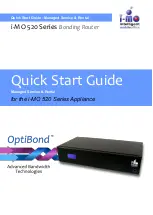
30
Table of Contents
Linksys
30
Table of Contents
Linksys
See Device Models for information concerning PoE support on various
models PoE provides the following features:
•
Eliminates the need to run 110/220 V AC power to all devices on a
wired LAN
•
Removes the necessity for placing all network devices next to power
sources
•
Eliminates the need to deploy double cabling systems in an enterprise,
significantly decreasing installation costs
Power over Ethernet can be used in any enterprise network that deploys
relatively low-powered devices connected to the Ethernet LAN:
•
IP phones
•
Wireless access points
•
IP gateways
•
Audio and video remote monitoring devices
PoE Operation
•
PoE implementation stages are as follows:
•
Detection—Sends special pulses on the copper cable When a PoE device
is located at the other end, that device responds to these pulses
•
Classification—Negotiation between the Power Sourcing Equipment
PSE) and the Powered Device (PD) commences after the Detection stage
During negotiation, the PD specifies its class, which is the amount of
maximum power that the PD consumes
•
Power Consumption—After the classification stage completes, the
PSE provides power to the PD If the PD supports PoE, but without
classification, it is assumed to be class 0 (the maximum) If a PD tries to
consume more power than permitted by the standard, the PSE stops
supplying power to the port
Power Modes
•
Power per port can be limited depending on the Power Mode:
•
Port Limit—Power is limited to a specified wattage For these settings to be
active, the system must be in PoE Port Limit mode That mode is configured
in the PoE Feature Configuration page When the power consumed on the
port exceeds the port limit, the port power is turned off
•
Class Limit—Power is limited based on the class of the connected PD For
these settings to be active, the system must be in PoE Class Limit mode
That mode is configured in the PoE Feature Configuration page When the
power consumed on the port exceeds the class limit, the port power is
turned off
PoE Priority Example
A 48-port device is supplying a total of 375 watts
The administrator configures all ports to allocate up to 30 watts each This
results in 48 times 30 ports equaling 1440 watts, which is too much The
device cannot provide enough power to each port, so it provides power
according to the priority The administrator sets the priority for each port,
allocating how much power it can be given
These priorities are entered in the PoE Port Limit Mode or Class Limit Power
Mode pages
See Device Models for a description of the device models that support PoE
and the maximum power that can be allocated to PoE ports
PoE Configuration Considerations
There are two factors to consider in PoE configuration:
•
The amount of power that the PSE can supply
•
The amount of power that the PD is attempting to consume
You can decide the following:
•
Maximum power a PSE is allowed to supply to a PD
•
POE mode—To change the mode from Class Power Limit to Port Limit,
and vice versa, during device operation The power values per port that
were configured for the Port Limit mode are retained
NOTE:
Changing the mode from Class Limit to Port limit, and vice versa, when the
device is operational forces the Powered Device to reboot
•
Maximum port limit allowed as a per-port numerical limit in mW (Port
Limit mode)
The PoE-specific hardware automatically detects the PD class and its power
limit according to the class of the device connected to each specific port
(Class Limit mode)
Содержание Smart Switch LGS3XX
Страница 1: ...Smart Switch LGS3XX User Guide ...
















































